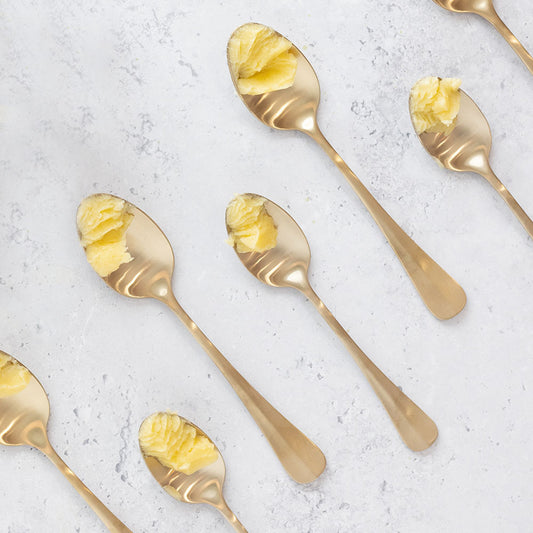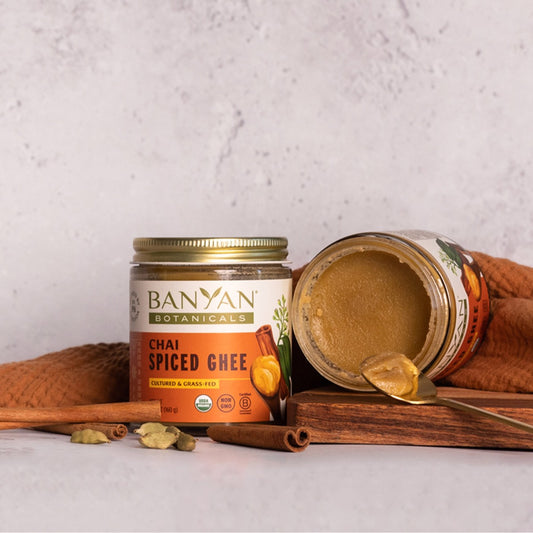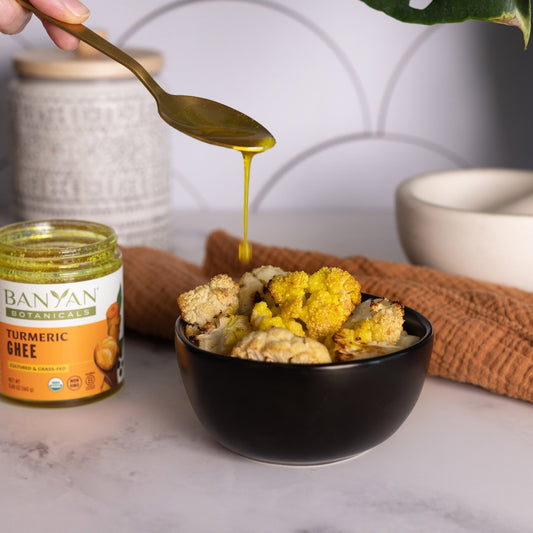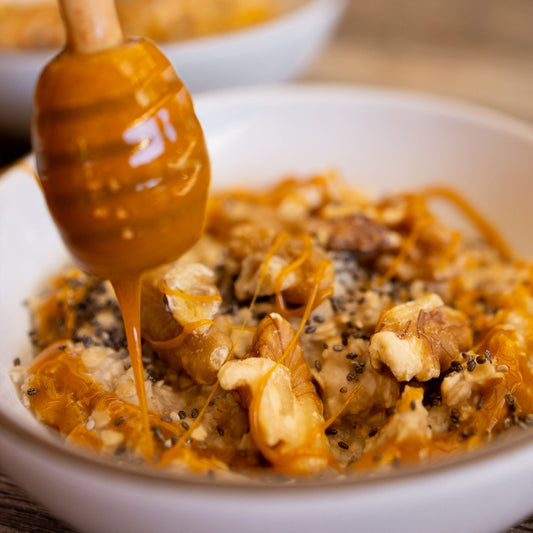Who doesn't love a heaping scoop of gheemelted over the top of their rice or kitchari? Yum! If you've ever been lucky enough to experience the rich, nourishing, and luxurious qualities of this golden nectar, you'll understand why
But have you ever wondered why ghee is so highly revered in
What Is Ghee?
Ghee is that beautifully golden yellow substance left over after the impurities of butter have been melted away.
Also known as clarified butter or anhydrous milk fat, ghee has been used for thousands of years in Ayurveda for cooking and religious ceremonies, as well as therapeutically, both internally and externally.
In traditional Ayurveda, the first step for making ghee starts with a process called "culturing," in which bacterial cultures are added to cow's milk and churned to make butter cream. The butter then goes through a clarification process which strips away the parts of butter that are the most difficult to digest, such as lactose, casein, whey proteins, and trace minerals.
Banyan's ghee is made with the finest cultured butter in alignment with this tradition. Cultured butter is considered to be easier to digest, more balancing to all three

Is Ghee Dairy Free?
While ghee is still technically considered a dairy product, it is the one dairy product that many with lactose-intolerance or other sensitivities (like casein) can and do eat! This makes it a favorite substitute for recipes that call for butter. Banyan's ghee is also free of gluten, sodium, trans fats, and GMOs.
Does Ghee Taste Like Butter?
Although ghee does not taste exactly like store-bought butter, it still has a delicious taste and a smooth, creamy quality. Some even consider it to be superior and don't want to return to regular butter after experiencing the taste—and benefits—of ghee!
Ghee's Health Benefits
The health benefits of ghee are numerous:
- Ghee's unctuous quality increases the juices of the body (
- Being a fatty base, ghee increases kapha within the body, and therefore increases the most refined byproduct of
- Likewise, ghee can facilitate the movement of toxins (
History of Ghee
The ancient seers viewed gheeas more than a food substance. As with all foods, ghee holds a certain energy. For example, garlic and onions have a heavy,
Because the sattvic energy is so pronounced in ghee, it is often an integral part of religious ceremonies in ancient
Still today, ghee is offered to
In Sanskrit, ghee is known as ghrta. It is derived from the base, ghr, which means “to shine.” It allows the body and mind to burn with a radiant aura and a refined brilliance, fueling dhi (intelligence), buddhi (intellect), and smrti (memory).
Ghee's unctuous quality makes all things soft and malleable, creating supple organs and a flexible and harmonious mind.
Its detoxifying benefits have made ghee a notable element in cleansing rituals. In fact, ingestion of ghee is a core part of traditional cleansing treatmentsand
In one striking study, it was found that panchakarma reduced mean levels of polychlorinated biphenyls, a common environmental toxin that is lipophilic, by an alarming 46%!2

How to Make Ghee
Historically, the process of making ghee began with churning butter by hand. Today most commercial butter is made by pushing the cream and protein of milk through a fine mesh screen versus churning the milk.
This creates a considerable difference, in that the traditional churning process with which ghee was often made added a stronger quality of digestive fire (agni), which balances the ghee and increases its sattvic energy. Though hand-churned butter may not be readily available, commercial butter still has similar beneficial properties.
To make ghee, gently boil a pound of unsalted butter on a stovetop until the milk solids settle to the bottom. Seperate the clarified butter and allow to cool. After the milk solids are removed, what remains is a high concentration of healthy fats and other nutrients.
Ghee does not need to be refrigerated. Keep it sealed and store it in a dry area out of direct sunlight.
The Nutritional Content of Ghee
Speaking of nutrients, it is said that ghee is 99% fat. This makes it naturally high in calories, containing 112 calories per 1 tablespoon serving, 12.7 grams of fat, minimal protein, and no carbohydrates, fiber, or sugars.
Most of the fat is saturated fat (60–65%)3, with a relatively greater concentration of short and medium chain triglycerides (25%, versus 12–15% in butter)4, which are known to have many health benefits.
With the milk solids removed, most of the calcium is also removed. On the other hand, ghee contains a whopping 108 micrograms of vitamin A (a natural antioxidant) in just one tablespoon!
Ghee also contains a considerable amount of butyric acid, a short chain fatty acid, which acts like a natural probiotic (the intestinal bacteria feed off this for energy), supporting digestion and the immune system.5
Of course, this is, at the end of the day, a kapha food. As the ancient tradition of Ayurveda says, it is important to make sure you consume only as much as your agni can handle. It is when we eat beyond the capacity of our agni that we run into various health issues, such as heart challenges or weight gain.
Herbal Ghee
Thanks to its penetrating qualities, ghee can act as a vehicle to carry substances deep into all seven tissue layers. It is a wonderful
Banyan offers two unique herbal ghees—a delicate golden colored Turmeric Ghee and a flavorful Chai Spiced Ghee with cinnamon and cardamom.
How to Use Ghee
Ghee can be used both internally and externally. Externally, ghee soothes and moisturizes, promoting soft, supple skin. When ingested, Ayurveda traditionally considers ghee nourishing to the digestive tract and internal tissues.
- Cooking with ghee is a popular component of most Ayurvedic recipes. Ghee is an ingredient in kitchari, baked apples, green mung beans, rice porridge, creamy urad masala, spiced rice with cashews, and more.
- For beauty, ghee makes an excellent skin moisturizer and natural eye makeup remover.
- Ghee is traditionally used to support Ayurvedic cleansing.
- The nourishing and hydrating qualities of ghee make it good for massage, particularly for dry or
- Consider using ghee for hair to add moisture and nourishment to dry follicles.
About Banyan's Cows
Banyan's ghee is made from the milk of organic, grass fed cows in Northern California. The farmers who care for them are award-winning producers of butter and take excellent care of their cows.
While it is possible to obtain less expensive versions of ghee that are derived from vegetable oil, these are typically high in trans-fats and best avoided. We believe it is of utmost importance to use ghee that comes from organic, grass-fed cows to receive the most extensive benefits of this wonderful, golden nectar.










